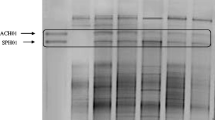Abstract
The microbiological characteristics of the bacterialdegradation of mixtures of five polycyclic aromatichydrocarbons (PAH), phenanthrene, fluorene,anthracene, fluoranthene and pyrene, wereinvestigated. Three pure bacterial strains using oneor several of these PAH as carbon sources wereselected. The interactions between PAH during thedegradation of PAH pairs by each of these strains werestudied and their effects on the kinetics and thebalance of degradation were characterised. Competitionbetween PAH and degradation by cometabolism werefrequently observed. Mixed cultures of two or threestrains, although possessing the global capacity tomineralise the set of five PAH, achieved limiteddegradation of the mixture. In contrast, a consortiumfrom a PAH-contaminated soil readily mineralised thefive-PAH mixture. The results suggested that soilconsortia possessed a wider variety of strains capableto compensate for the competitive inhibition betweenPAH as well as specialised strains that mineralisedpotentially inhibitory PAH metabolites produced bycometabolism.
Similar content being viewed by others
References
Alexander M (1965) Biodegradation: Problems of molecular recalcitrance and microbial fallibility. Adv. Appl. Microbiol. 7: 35-80
Arino S, Marchal R & Vandecasteele JP (1998) Involvement of a rhamnolipid-producing strain of Pseudomonas aeruginosa in the degradation of polycyclic aromatic hydrocarbons by a bacterial community. J. Appl. Microbiol. 84: 769-776
Boldrin B, Tiehm A & Fritzsche C (1993) Degradation of phenanthrene fluorene, fluoranthene and pyrene by a Mycobacterium sp. Appl. Environ. Microbiol. 59: 1927-1930
Bouchez M, Blanchet D, Besnainou B, Leveau JY & Vandecasteele JP (1997) Kinetic studies of biodegradation of insoluble compounds by continuous determination of oxygen consumption. J. Appl. Microbiol. 82: 310-316
Bouchez M, Blanchet D & Vandecasteele JP (1995) Degradation of polycyclic aromatic hydrocarbons by pure strains and defined strain associations: inhibition phenomena and cometabolism. Appl. Microbiol. Biotechnol. 43: 156-164
Bouchez M, Blanchet D & Vandecasteele JP (1996a) The microbiological fate of polycyclic aromatic hydrocarbons: carbon and oxygen balances for bacterial degradation of model compounds. Appl. Microbiol. Biotechnol. 45: 556-561
Bouchez M, Blanchet D, Haeseler F & Vandecasteele JP (1996b) Les hydrocarbures aromatiques polycycliques dans l'environnement. Deuxième partie. La dégradation microbienne. Revue de l'Institut Français du Pétrole 51: 797-828
Cerniglia CE (1993) Biodegradation of polycyclic aromatic hydrocarbons. Current Opinion in Biotechnology 4: 331-338
Grifoll M, Selifonov SA, Gatlin CV & Chapman P (1995) Actions of a versatile fluorene-degrading bacterial isolate on polycyclic aromatic compounds. Appl. Environ. Microbiol. 61: 3711-3723
Heitkamp MA & Cerniglia CE (1988) Mineralization of polycyclic aromatic hydrocarbon degradation by a bacterium isolated from sediment below an oil field. Appl. Environ. Microbiol. 54: 1612-1614
Kästner M, Breuer-Jammali M & Mahro B (1994) Enumeration and characterization of the soil microflora from hydrocarbon-contaminated soil sites able to mineralize polycyclic aromatic hydrocarbons (PAH). Appl. Microbiol. Biotechnol. 41: 267-273
Keck J, Sims RC, Coover M, Park K & Symons B (1989) Evidence for cooxidation of polynuclear aromatic hydrocarbons in soil. Wat. Res. 23: 1467-1476
Logan BE & Rittmann BE (1998) Finding solutions for tough environmental problems. Environ. Sci. & Technol. 502A-507A
Mueller JG, Chapman PJ, Blattmann BO & Pritchard PH (1990) Isolation and characterization of a fluoranthene-utilizing strain of Pseudomonas paucimobilis. Appl. Environ. Microbiol. 56: 1079-1086
Mueller JG, Chapman PJ & Pritchard PH (1989) Action of a fluoranthene-utilizing bacterial community on polycyclic aromatic hydrocarbon components of creosote. Appl. Environ. Microbiol. 55: 3085-3090
Mueller JG, Devereux R, Santavy DL, Lantz SE, Willis SG & Pritchard PH (1997) Phylogenetic and physiological comparisons of PAH-degrading bacteria from geographically diverse soils. A. van Leeuwenhoek 71: 329-343
Perry JJ (1979) Microbial cooxidation involving hydrocarbons. Microbiol. Rev. 43: 59-72
Stieber M, Haeseler F, Werner P & Frimmel FH (1994) A rapid screening method for microorganisms degrading polycyclic aromatic hydrocarbons in microplates. Appl. Microbiol. Biotechnol. 40: 753-755
Stringfellow WT & Aitken MD (1995) Competitive metabolism of naphthalene, methylnaphthalenes and fluorene by phenanthrene-degrading Pseudomonads. Appl. Environ. Microbiol. 61: 357-362
Walter U, Beyer M, Klein J & Rehm HJ (1991) Degradation of pyrene by Rhodococcus sp. UW 1. Appl. Microbiol. Biotechnol. 34: 671-676
Weissenfels WD, Beyer M, Klein J & Rehm HJ (1991) Microbial metabolism of fluoranthene: isolation and identification of ring fission products. Appl. Microbiol. Biotechnol. 34: 528-535
Wiesel I, Wübker SM & Rehm HJ (1993) Degradation of polycyclic aromatic hydrocarbons by an immobilized mixed bacterial culture. Appl. Microbiol. Biotechnol. 39: 110-116
Ye D, Siddiqui MA, Maccubin AE, Kumar S & Sikka HC (1996) Degradation of polynuclear aromatic hydrocarbons by Sphingomonas paucimobilis. Environ. Sci. Technol. 30: 136-142
Author information
Authors and Affiliations
Corresponding author
Rights and permissions
About this article
Cite this article
Bouchez, M., Blanchet, D., Bardin, V. et al. Efficiency of defined strains and of soil consortia in the biodegradation of polycyclic aromatic hydrocarbon (PAH) mixtures. Biodegradation 10, 429–435 (1999). https://doi.org/10.1023/A:1008382030604
Issue Date:
DOI: https://doi.org/10.1023/A:1008382030604




